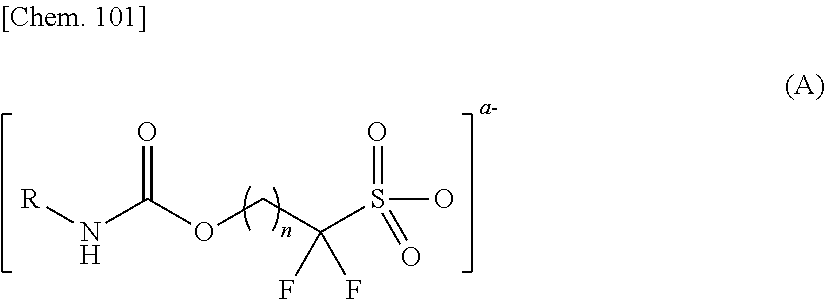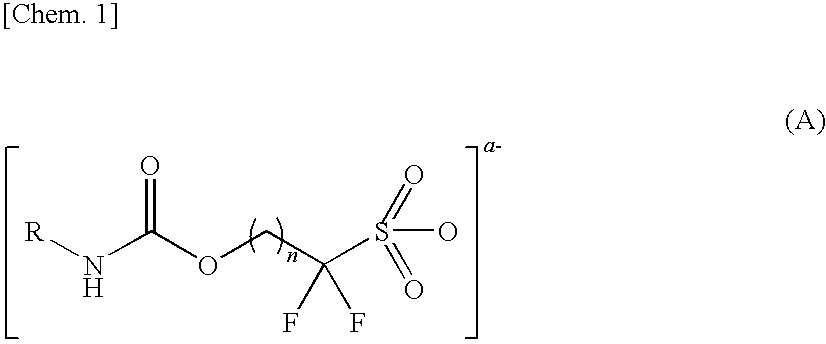Sulfonic acid salt and derivative thereof, photoacid generator agent, and resist material and pattern formation method using the photoacid generator agent
a generator agent and sulfonic acid salt technology, applied in the direction of photosensitive materials, instruments, photomechanical equipment, etc., can solve the problems of resist film not obtaining a high level of surface flatness, deterioration of pattern dimension system, loss of device electrical characteristics, etc., to achieve a higher-resolution resist pattern, good performance, and better compatibility with resist material
- Summary
- Abstract
- Description
- Claims
- Application Information
AI Technical Summary
Benefits of technology
Problems solved by technology
Method used
Image
Examples
example 1-1
Preparation of 2-bromo-2,2-difluoroethyl-cyclohexylcarbamate
[0241]
[0242]A 50-mL reaction vessel was charged with 10.0 g (79.9 mmol / 1.0 equivalent) of cyclohexyl isocyanate and 25.1 g (156 mmol / 2.0 equivalent) of bromo difluoro ethanol. The resulting solution was stirred at 40° C. for about 18 hours and, after stopping the stirring, subjected to vacuum drying at 60° C., thereby yielding 23.1 g of 2-bromo-2,2-difluoroethyl-cyclohexylcarbamate as a target product. The yield of the product was 85%.
Properties of 2-bromo-2,2-difluoroethyl-cyclohexylcarbamate
[0243]1H NMR (CDCl3) δ 4.77 (br, 1H, NH), 4.55 (t, J=11.7 Hz, 2H, CH2—O), 3.46 (m, 1H, CH), 1.93 (m, 2H, CH2), 1.70 (m, 2H, CH2), 1.59 (m, 1H), 1.33 (m, 2H, CH2), 1.15 (m, 3H).
[0244]19F NMR (CDCl3) δ-57.0 (t, J=12 Hz, 2F).
example 1-2
Preparation of sodium cyclohexylcarbamic acid-2,2-difluoroethylsulfonate
[0245]
[0246]A 500-mL reaction vessel was charged with 23.0 g (67.5 mmol) of 2-bromo-2,2-difluoroethyl-cyclohexylcarbamate, followed by adding thereto 100 g of acetonitrile and dissolving the 2-bromo-2,2-difluoroethyl-cyclohexylcarbamate in the acetonitrile. The resulting solution was mixed with 29.0 g (167 mmol) of sodium dithionite, 17.0 g (202 mmol) of sodium hydrogen carbonate and 100 g of water, and then, stirred at 60° C. for about 113 hours. After stopping the stirring, the solution was separated into two phases. The aqueous phase was extracted four times with 100 g of acetonitrile. The thus-obtained organic phases were combined together. The acetonitrile solvent was removed from the combined organic phase fraction by concentration. With this, 38.3 g (purity: 42%) of a light-yellow solid substance was obtained.
[0247]A 200-mL reaction vessel was charged with 38.2 g (54.2 mmol, purity: 42%) of the obtained s...
example 2
Preparation of triphenylsulfonium cyclohexylcarbamic acid-2,2-difluoroethylsulfonate
[0250]
[0251]A 300-mL reaction vessel was charged with 31.85 g (purity: 47%, 48.0 mmol) of sodium cyclohexylcarbamic acid-2,2-difluoroethylsulfonate, 15.8 g (52.9 mmol) of triphenylsulfonium chloride, 170 g of water and 30 g of chloroform. The resulting solution was stirred for 4 hours at room temperature and separated into two phases. The aqueous phase was extracted with chloroform. The thus-obtained organic phases were combined together. The combined organic phase faction was washed six times with water, subjected to concentration, washed three times with diisopropyl ether, and then, dried, thereby yielding 24.5 g of triphenylsulfonium cyclohexylcarbamic acid-2,2-difluoroethylsulfonate as a target product. The purity of the product was 76%; and the yield of the product was 70%.
Properties of triphenylsulfonium cyclohexylcarbamic acid-2,2-difluoroethylsulfonate
[0252]1H NMR (CDCl3) δ 7.80-7.58 (m, 15H)...
PUM
 Login to View More
Login to View More Abstract
Description
Claims
Application Information
 Login to View More
Login to View More - R&D
- Intellectual Property
- Life Sciences
- Materials
- Tech Scout
- Unparalleled Data Quality
- Higher Quality Content
- 60% Fewer Hallucinations
Browse by: Latest US Patents, China's latest patents, Technical Efficacy Thesaurus, Application Domain, Technology Topic, Popular Technical Reports.
© 2025 PatSnap. All rights reserved.Legal|Privacy policy|Modern Slavery Act Transparency Statement|Sitemap|About US| Contact US: help@patsnap.com



